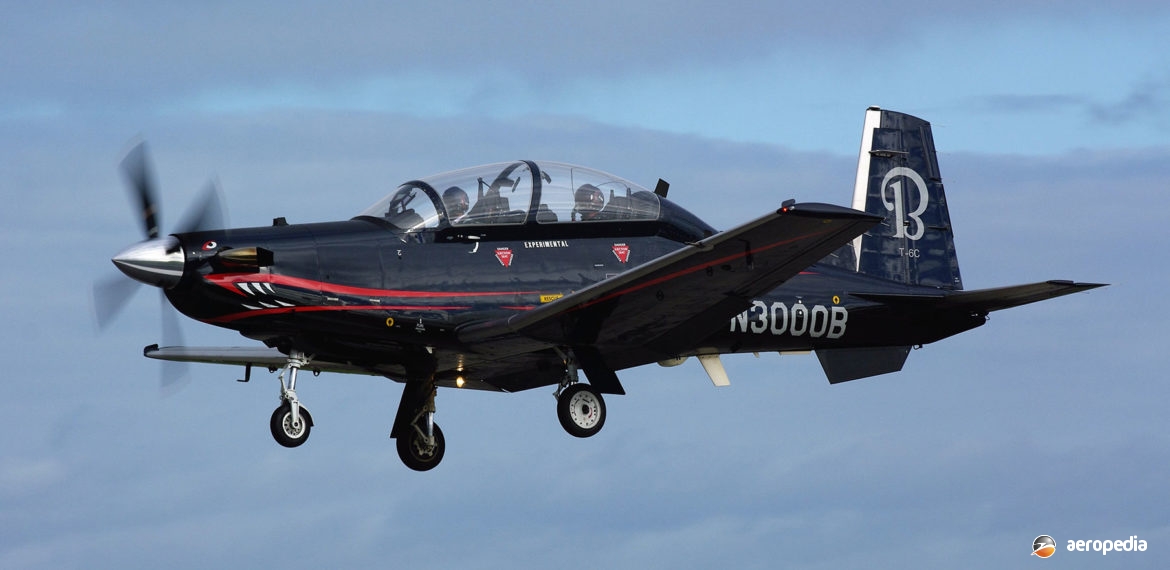Photograph:
Beechcraft T-6C Texan II N3000B at Avalon, VIC on 24 February 2015 (David C Eyre)
Country of origin:
United States of America
Description:
Two-seat military trainer
Power Plant:
One 821 kw (1,100 shp) Pratt & Whitney Canada PT6A-68 turboprop
Specifications:
- Wingspan: 10.2 m (33 ft 5 in)
- Length: 10.16 m (33 ft 4 in)
- Height: 3.25 m (10 ft 8 in)
- Wing area: 16.28 m² (175.3 sq ft)
- Max speed: 586 km/h (364 mph)
- Cruising speed at 305 m (1,000 ft): 500 km/h (311 mph)
- Rate of climb: 945 m/min (3,100 ft/min)
- Service ceiling: 9,449 m (31,000 ft)
- Range: 1,575 km (978 miles)
- Fuel capacity: 678 litres (149 Imp gals)
- Max ferry range without external tanks: 1,637 km (1,017 miles)
- Max ferry range with two external fuel tanks: 2,559 km (1,590 miles)
- Empty weight: 2,336 kg (5,150 lb)
- Total internal fuel: 544 kg (1,200 lb)
- Total fuel with two external tanks: 932 kg (2,054 lb)
- Loaded weight: 3,130 kg (6,900 lb)
History:
Initially known as the Raytheon T-6 Texan II, the Texan II was a single-engine turboprop-powered advanced trainer produced for the United States Air Force. Initially built by Raytheon, this company later became Hawker Beechcraft, and eventually the Beechcraft Corporation. It was basically based on the Pilatus PC-9. First deliveries were made to the USAF for pilot training and to the US Navy for Primary and Intermediate Joint Naval Flight Officer and Air Force Combat Systems Officer training. It replaced the Cessna T-37 series in these roles and was later supplied to the Royal Canadian Air Force as the CT-56 Harvard II, as well as the air forces of Germany, Greece, Israel and Iraq. A modified variant known as the T-6C was supplied to the air forces of Morocco and Mexico.
On 27 January 2014 the New Zealand Defence Minister announced the RNZAF would acquire 11 examples of the T-6C as part of a military training package, this including ground simulators, and classroom and computer-based training packages. Deliveries of these aircraft commenced in 2015 and the first training course using the type commenced in early 2016, No 14 Squadron RNZAF being re-raised to operate the type.
The T-6 was a significantly modified Pilatus PC-9 developed to enter the US Joint Primary Aircraft Training System competition in the 1990s and was selected under the United States Tri-Service aircraft designation system. Additional requirements by the USAF and US Navy resulted in delays to the program and the aircraft was 499 kg (1,100 lb) heavier than the PC-9. It entered USAF service in 2000 at Moody and Randolph Air Force Bases, and later at Lauglin, Vance, Colombus and Sheppard Bases. It replaced Cessna T-34Cs at Naval Air Station Pensacola in 2005, followed by Whiting Field and Corpus Christi. In Canadian service it has been used for instruction at the NATO Flying Training Wing at Moose Jaw, Saskatchewan.
A number of variants have been produced, including the T-6A; T-6A NTA armed variant for Greece with a capability of carrying rocket pods, gun pods, fuel tanks externally, and bombs; the T-6B with a digital glass cockpit; the AT-6B, an armed variant of the T-6B for primary weapons training or light attack; the T-6C, an upgraded variant of the T-6B with wing hard-points, intelligence, surveillance and reconnaissance capabilities; and the CT-156 variant for Canada.
In February 1996 Raytheon, which at the time was the owner of Hawker Beechcraft, was awarded the JPATS acquisition and support contract, the first operational aircraft being delivered to Randolph Air Force Base in Texas in May 2000, the aircraft entering full production in December 2001. Initial deliveries to the USAF were 453 T-6As, and 315 were to be purchased for the US Navy but this was reduced to 297 examples. The aircraft was capable of teaching the most advanced aerobatic manoeuvres and simulated combat training tasks and incorporated hard-points on the wings for external fuel tanks.
The first T-6C for the RNZAF NZ1401 / N2824B made its first flight at the Company’s facility at Wichita, Kansas on 6 October 2014. The first two aircraft landed at Whenuapai in Auckland on 22 August 2014 after being flown from Wichita, making 20 stops on the way. These aircraft were formally handed over to the RNZAF in October 2014 after initial pilot and maintenance training. The second two aircraft (c/ns 4 and 5) arrived in Darwin, NT later in October, and the next two passed through Australia on their way to New Zealand in November 2014.
Two examples visited the Australian International Air Show at Avalon in February 2015. These aircraft with US registrations (N2770B and N2763B) stayed for the duration of the show to be demonstrated to Australian Defence personnel as it was expected that during the show the long awaited decision as to a new trainer for the RAAF would be announced by the Australian Minister for Defence. However, this announcement was not made and, after the show, the aircraft continued to New Zealand to be delivered and enter service with the RNZAF, the RAAF eventually acquiring the Pilatus PC-21.
The last two Texan IIs for the RNZAF were delivered to Ohakea on 17 April 2015, these being N2773B and N2786B which became NZ1410 and NZ1411 respectively.
In early 2016 it was announced the RNZAF would hold an 80th Anniversary Air Tattoo at RNZAF Base Ohakea in February 2017 to showcase the latest air capability of the Air Force, and one of the aircraft to be displayed was to be the T-6 Texan II flown by the newly formed five-aircraft formation team known as the ‘Black Falcons‘. The pilots for the team were qualified flying instructors from both the Central Flying School and No 14 Squadron.

